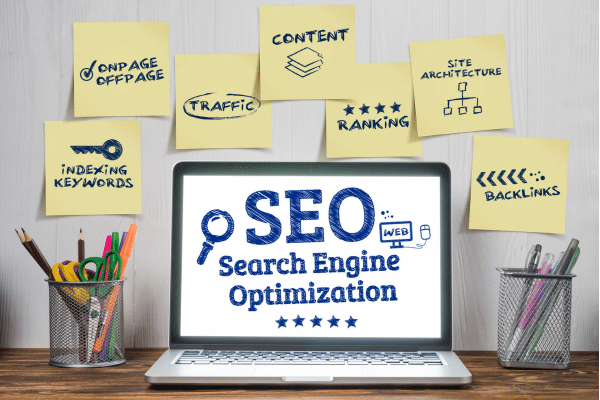- 619-846-5963
- Book A Discovery Call
- [email protected]
- 830 Kuhn Dr. Suite 210725, Chula Vista CA, 91921

In the ever-evolving digital marketplace, the importance of SEO for ecommerce cannot be overstated. As we venture into 2024, the online retail landscape is more competitive than ever, making it crucial for ecommerce businesses to leverage every tool at their disposal to stand out, attract, and retain customers. This guide is your key to unlocking the full potential of ecommerce SEO strategies, designed to navigate the complexities of digital visibility and ensure your products don’t just exist online, but thrive.
SEO for ecommerce has transformed from a mere buzzword into a vital necessity for online retailers. In a world where consumer behaviors and search engine algorithms are in constant flux, staying ahead means not just keeping pace with SEO trends but anticipating and adapting to changes with agility and insight. Whether you’re a burgeoning online store or an established ecommerce powerhouse, mastering SEO is no longer optional—it’s fundamental to your success.
The cornerstone of achieving this lies in keyword optimization, a strategy as critical as the inventory you manage. In 2024, the way shoppers search for products has evolved, demanding a nuanced approach to how to optimize your ecommerce site for SEO. It’s not just about what you sell, but how you present it to the digital world—ensuring your products are visible to the right audience, at the right time.
Yet, SEO encompasses far more than keywords. It’s about creating a seamless, engaging online experience that caters to both human users and search engine bots. From the architecture of your ecommerce site to the content that populates it, every element plays a pivotal role in your site’s ability to rank well and convert browsers into buyers. This guide will delve into the top ecommerce SEO strategies for 2024, offering actionable insights into on-page optimization, technical SEO, content marketing, and beyond.
Tailored to our ecommerce buyer persona, this guide speaks directly to you—the visionary behind the online store. Whether you’re aiming to enhance your site’s visibility, drive more targeted traffic, or increase sales through organic search, you’ll find valuable, actionable strategies within these pages. We’ll explore real-life examples, dissect the latest trends, and provide you with a blueprint to elevate your ecommerce SEO game.
As we embark on this journey together, remember that SEO is both an art and a science—a dynamic blend of creativity, analytics, and technical prowess. Ready to dominate the digital shelf space in 2024? Let’s dive into the world of SEO for ecommerce, transforming challenges into opportunities and aspirations into achievements.

Simply put, ecommerce SEO involves optimizing your online store so that your products and pages rank as highly as possible on search engines like Google. It’s about ensuring that when potential customers search for products you offer, your store appears in the top results, ready to meet their needs. This process involves a meticulous blend of keyword optimization, site structure analysis, and creating an engaging user experience that both search engines and users value.
In a digital era where the majority of shopping journeys begin with a search engine query, being invisible on search results pages means missing out on vast potential revenue. The right ecommerce SEO strategies can catapult your store to the forefront of these search results, capturing the attention of those actively seeking your products.
As we move into 2024, the landscape of SEO for ecommerce continues to evolve. Search engines are becoming more sophisticated, prioritizing sites that offer genuine value to users. This means that outdated tactics no longer suffice. Modern ecommerce SEO strategies must focus on comprehensive keyword optimization, ensuring content relevance, and enhancing site performance to meet the fast-evolving standards of search algorithms and user expectations.
Understanding that each ecommerce niche has unique SEO demands is crucial. Whether you’re selling handmade crafts or high-tech gadgets, the principles of how to optimize your ecommerce site for SEO remain the same, but the application should be tailored. Identifying the right keywords, understanding your audience’s search intent, and crafting content that addresses their queries are foundational steps in this process.
Beyond keywords and content, the technical aspects of your site play a significant role in your SEO success. This includes site speed, mobile responsiveness, and the security of your online store. Ensuring a seamless shopping experience not only boosts your SEO rankings but also directly impacts your conversion rates and customer satisfaction levels.
In conclusion, grasping the fundamentals of SEO for ecommerce is the first step toward unlocking the full potential of your online store in 2024. By prioritizing ecommerce SEO strategies that align with current best practices and search engine algorithms, you position your ecommerce business for visibility, growth, and success in the competitive digital marketplace.
The journey to ecommerce SEO excellence begins with thorough keyword research. This process involves identifying the terms and phrases your potential customers use when searching for products you offer. Utilizing tools like Google’s Keyword Planner, Ahrefs, or SEMrush can provide insights into search volume, competition levels, and keyword relevance. It’s crucial to focus on both short-tail and long-tail keywords, as the latter often indicates a higher intent to purchase and can lead to more targeted traffic.
For example, while “women’s hats” might have a higher search volume, “handmade women’s sun hats” can attract a more specific audience looking for exactly what you offer. Including ecommerce SEO strategies that target a mix of these keywords can significantly enhance your site’s visibility and relevance.

Once you’ve identified your target keywords, the next step is to integrate them naturally into your website. This includes optimizing product titles, descriptions, meta tags, and URLs. However, keyword optimization goes beyond mere inclusion. It’s about crafting content that answers the queries behind the searches. For instance, product descriptions should not only describe the item but also explain its benefits, usage, and why it’s the best choice for the customer.
Effective SEO for ecommerce also involves creating valuable content beyond product listings. Blog posts, buying guides, and FAQ sections that incorporate your targeted keywords can attract a broader audience and establish your site as a trusted resource. For 2024, focusing on topics that address specific customer queries, such as “how to optimize your ecommerce site for SEO” or “top ecommerce SEO strategies 2024”, can position your site as a leader in your niche.
SEO is not a set-it-and-forget-it endeavor. Regularly reviewing your keyword strategy to reflect changing market trends, consumer behavior, and algorithm updates is essential. Utilizing analytics to monitor the performance of your keywords and making adjustments as needed can ensure your ecommerce site remains competitive and visible to your target audience.
In conclusion, keyword research and optimization are foundational to the success of any ecommerce website. By understanding and implementing effective strategies tailored to your specific audience and products, you can enhance your online store’s visibility, attract more targeted traffic, and ultimately, increase conversions in the competitive ecommerce landscape of 2024.

Your title tags and meta descriptions are among the first things potential customers will see in search results. They should be compelling and include main keywords that reflect the content of the page, enticing users to click through to your site. For example, a title tag for a product page might be “Buy Handcrafted Women’s Sun Hats | [Your Brand Name],” incorporating both the product type and brand for keyword optimization.
Product descriptions offer a prime opportunity to include long-tail keywords, such as “how to optimize your ecommerce site for SEO,” by providing detailed, keyword-rich content that genuinely helps the shopper make an informed decision. Similarly, optimizing images with descriptive, keyword-focused alt text can improve visibility in image search results, enhancing overall SEO.
In 2024, UX and mobile optimization are not just beneficial for SEO; they’re imperative. A website that’s easy to navigate and loads quickly on all devices, especially smartphones, can significantly impact your site’s bounce rate and average session duration, both of which are critical SEO ranking factors. Ensuring your ecommerce site is responsive and offers an intuitive shopping experience is key to keeping potential customers engaged.
Schema markup is a powerful tool for ecommerce websites, allowing you to provide search engines with detailed information about your products, such as price, availability, and reviews. This can result in rich snippets, which enhance visibility in search results and can increase click-through rates. For instance, adding schema markup for product pages can help display star ratings in search results, immediately drawing the eye of potential buyers.
Beyond product pages, creating valuable, informative content related to your niche can attract more traffic and build authority. Blog posts, buying guides, and how-to articles that incorporate ecommerce SEO strategies and relevant keywords can drive organic traffic and encourage longer site visits, contributing positively to your SEO efforts.
In conclusion, on-page SEO for ecommerce sites involves a multifaceted approach focused on optimizing content, improving user experience, and providing clear signals to search engines about the relevance and value of your pages. By implementing these strategies, you can enhance your online store’s visibility, attract more targeted traffic, and ultimately, increase conversions in the competitive ecommerce landscape.

A well-organized site structure not only enhances user navigation but also helps search engines crawl your site more effectively. For ecommerce SEO, this means organizing your products into logical categories and subcategories, using breadcrumb navigation, and ensuring each page is accessible with as few clicks as possible from the home page. A clear, intuitive site structure supports keyword optimization by grouping related products, enhancing the relevancy signals sent to search engines.
Page speed is a critical ranking factor for Google, and it’s paramount for ecommerce sites where every second counts towards keeping a potential customer engaged. Utilizing tools like Google’s PageSpeed Insights can provide actionable recommendations to improve your site’s loading time. Techniques such as compressing images, leveraging browser caching, and minimizing CSS and JavaScript can drastically reduce load times, improving both SEO for ecommerce and user experience.
With the majority of online shoppers using mobile devices, having a mobile-optimized site is non-negotiable. This involves responsive design, ensuring your site adjusts seamlessly to any screen size, and optimizing for mobile usability, such as touch-friendly navigation and easily accessible CTA buttons. Mobile optimization not only caters to user behavior but significantly impacts your SEO rankings, aligning with Google’s mobile-first indexing.
Schema markup is a powerful form of microdata that tells search engines exactly what your content is about, enabling richer, more informative search results. For ecommerce sites, implementing product schema can highlight prices, availability, and reviews directly in search results, making your listings more attractive and informative to potential buyers. This can lead to higher click-through rates and improved ecommerce SEO performance.
Security is a top priority for online shoppers. Ensuring your ecommerce site uses HTTPS encryption not only protects your customers’ data but also contributes to your SEO efforts. Google has confirmed HTTPS as a ranking signal, meaning secure sites may receive a ranking boost over non-secure sites.
In conclusion, mastering technical SEO for your ecommerce site involves a comprehensive approach that addresses site structure, speed, mobile usability, schema markup, and security. By prioritizing these technical aspects, you can create a strong foundation for your SEO for ecommerce, ensuring your site is both user-friendly and highly visible in search engine results. Embracing these practices is essential for ecommerce businesses aiming to succeed and grow in the digital marketplace of 2024.

Content marketing for ecommerce transcends mere product descriptions. It encompasses blogs, buying guides, how-to articles, and videos that not only showcase your products but also provide value to your audience. This approach helps in addressing long-tail keywords like “how to optimize your ecommerce site for SEO,” which are crucial for driving targeted traffic and improving search rankings.
The first step in a successful content marketing strategy is identifying topics that resonate with your target audience. Use customer queries, market research, and keyword optimization tools to discover subjects that interest your potential customers. Creating content that answers these queries not only positions your brand as an authority but also improves your site’s visibility in search results.
Blogging is an invaluable strategy for ecommerce SEO, allowing you to delve deeper into topics related to your products and industry. Each blog post is an opportunity to incorporate ecommerce SEO strategies and keywords, improving your site’s indexation and attracting organic traffic. For instance, a blog post titled “Top Ecommerce SEO Strategies 2024” can attract readers looking to enhance their own ecommerce platforms, driving relevant traffic to your site.
Video content has surged in popularity and effectiveness, offering a dynamic way to showcase products and share informational content. Embedding product demonstrations, customer testimonials, or “how-to” videos on your site can significantly increase user engagement, time on site, and provide additional opportunities for keyword optimization.
Encouraging user-generated content, such as customer reviews and Q&A sections, not only fosters a sense of community around your brand but also contributes to your site’s SEO. This content is rich in natural language and keywords relevant to your products, enhancing your site’s relevance and authority.
In conclusion, integrating a robust content marketing strategy into your ecommerce SEO efforts is essential for building brand authority, engaging potential customers, and driving organic traffic. By focusing on creating valuable, relevant content and optimizing it for search engines, you can elevate your ecommerce brand’s visibility and success in the digital marketplace of 2024.
In conclusion, mastering technical SEO for your ecommerce site involves a comprehensive approach that addresses site structure, speed, mobile usability, schema markup, and security. By prioritizing these technical aspects, you can create a strong foundation for your SEO for ecommerce, ensuring your site is both user-friendly and highly visible in search engine results. Embracing these practices is essential for ecommerce businesses aiming to succeed and grow in the digital marketplace of 2024.

Backlinks, or inbound links from other websites to yours, signal to search engines that others vouch for your content. But quality trumps quantity. Links from reputable, relevant sites have more SEO weight and can significantly impact your site’s ranking. For ecommerce sites, obtaining links from industry leaders, popular bloggers, or reputable directories can enhance visibility and credibility.
One effective way to earn quality backlinks is by creating content that others want to share. This includes comprehensive buying guides, insightful blog posts on trends within your niche, or original research and data. Content that provides value is more likely to be linked by other websites, including industry blogs, news sites, and forums. Incorporating keywords like “top ecommerce SEO strategies 2024” into your content can also increase its discoverability and shareability.
Guest blogging on reputable sites within your industry can be a win-win for link building and exposure. By contributing valuable content to other platforms, you not only get a backlink but also tap into their audience. Ensure the content you provide is relevant to both your niche and the host site’s audience, maximizing the impact of your ecommerce SEO strategies.
Product reviews and influencer collaborations can be goldmines for quality backlinks. Offering products for review to respected bloggers or influencers in your sector not only generates backlinks but also exposes your brand to a wider audience. Ensure these partnerships are disclosed and transparent, maintaining the integrity of your link building efforts.
While links from social media and forums may not always carry direct SEO weight, they contribute to the overall visibility and discoverability of your content. Active engagement on platforms relevant to your ecommerce niche can lead to natural backlinking as users share and discuss your content or products. Encourage this interaction by creating compelling, shareable content and engaging directly with your community.
Regularly monitor your site’s backlink profile using tools like Ahrefs or Moz to assess the quality of your inbound links. This not only helps you understand the impact of your link building efforts but also enables you to identify and disavow any potentially harmful links that could penalize your SEO performance.
In conclusion, a strategic approach to link building can significantly enhance the authority and visibility of your ecommerce site. By focusing on quality over quantity, creating share-worthy content, engaging in guest blogging, leveraging reviews, and actively participating in relevant online communities, you can build a robust link profile that supports your SEO for ecommerce goals and drives sustainable growth.

Social media platforms offer a unique opportunity to showcase your brand’s personality, values, and products. Consistently sharing high-quality content, engaging with followers, and promoting your products can build brand awareness and authority. This increased visibility often leads to more searches for your brand on search engines, positively influencing your SEO for ecommerce.
Content shared on social media that resonates with your audience can drive significant traffic to your ecommerce site. Whether it’s blog posts, product launches, or special promotions, compelling content encourages users to click through to your website. Including targeted keywords in your social media posts and using hashtags strategically can also improve visibility and engagement.
High-quality, engaging content shared on social media has the potential to go viral, attracting attention from content creators and influencers who may link back to your site in their own content. These backlinks, especially from high-authority sites, can greatly enhance your site’s SEO profile. Creating content that’s informative, entertaining, or both encourages sharing and can lead to natural link-building opportunities.
Social listening tools allow you to monitor mentions of your brand, products, and industry trends across social media platforms. This insight can inform your content strategy, helping you create blog posts, videos, and other content types that address your audience’s interests and questions. Incorporating relevant long-tail keywords like “how to optimize your ecommerce site for SEO” into this content can further boost your SEO efforts.
Featuring social media feeds or share buttons on your ecommerce site encourages visitors to engage with your brand across platforms. This not only enhances user experience but can also lead to increased social sharing, further amplifying your content’s reach and potential for backlinks.
In conclusion, social media plays a crucial role in amplifying your ecommerce SEO efforts. By building a strong social media presence, creating shareable content, and engaging with your audience, you can drive traffic, encourage backlinks, and enhance your brand’s visibility both on social platforms and search engines. As we look towards 2024, integrating ecommerce SEO strategies with a proactive social media approach will be key to achieving sustained online success.

The success of ecommerce SEO strategies can be gauged through several key metrics, each offering insights into different aspects of your SEO performance:
Several tools can help you monitor these metrics, providing the insights needed to adjust your strategies:
Collecting data is only the first step. The key lies in analyzing this information to understand the strengths and weaknesses of your SEO for ecommerce efforts. For example, if you notice a high bounce rate on product pages, it might be time to revisit your content marketing or page layout strategies. Similarly, if certain keywords are not performing as expected, it may indicate a need for deeper keyword research or adjustments in your content optimization.
It’s important to set realistic SEO goals based on your analysis. SEO is a long-term strategy, and improvements can take time to manifest. Establishing clear, measurable objectives, such as increasing organic traffic by a certain percentage or achieving top 5 rankings for key long-tail keywords, can help you stay focused and measure progress over time.
In conclusion, measuring the success of your ecommerce SEO strategies is an ongoing process that requires the right tools, a clear understanding of key metrics, and the ability to adapt based on data-driven insights. By closely monitoring your site’s performance and staying abreast of SEO best practices, you can ensure your ecommerce site not only ranks well but also meets its ultimate goal: driving sales and growing your business.

SEO is not a one-time endeavor but a continuous journey of adaptation and growth. The digital world is ever-evolving, with search engines constantly refining their algorithms and users’ expectations growing. Staying attuned to these changes, and ready to evolve your SEO strategies accordingly, is crucial for sustained success. Remember, the goal of SEO for ecommerce isn’t just to attract traffic but to convert that traffic into loyal customers.
Armed with the insights from this guide, you’re now equipped to make informed decisions that align with your ecommerce goals and the latest SEO best practices. Whether it’s refining your keyword optimization approach, enhancing your site’s user experience, or leveraging content marketing to build brand authority, every action you take should be data-driven and goal-oriented.
As you implement your SEO strategy, keep in mind our ecommerce buyer persona and avatar. Understand that behind every search query is a person seeking a solution—a solution that your ecommerce site can provide. Tailor your SEO efforts to not just meet but exceed their expectations, fostering a user experience that converts visitors into customers and brand advocates.
The road to ecommerce SEO success is paved with dedication, innovation, and continuous learning. We encourage you to start by applying the actionable takeaways from this guide, monitoring your progress, and being open to refining your strategies as you gather more insights. Remember, the ultimate measure of SEO success is the growth and satisfaction of your customer base.
Keep expanding your knowledge by staying updated with SEO trends and best practices. Engage with communities, attend webinars, and follow thought leaders in the SEO and ecommerce spaces. The landscape of SEO is dynamic, and staying informed will ensure you remain competitive.
In closing, this guide to SEO for ecommerce in 2024 is your springboard to achieving greater visibility, engagement, and conversion. With a commitment to excellence, a willingness to adapt, and a focus on creating value for your customers, there’s no limit to the success your ecommerce business can achieve. Here’s to your SEO journey—may it be challenging, rewarding, and above all, successful.

Bringing this comprehensive journey through the nuances of SEO for ecommerce to a practical culmination, our Actionable Takeaways section is designed to distill the insights and strategies we’ve explored into concise, impactful steps you can implement today. Whether you’re refining your keyword optimization techniques, enhancing your site’s user experience, or leveraging the power of content marketing, these takeaways are your blueprint for success.
Tailored to the needs and aspirations of our ecommerce buyer persona, this section aims to transform the complexity of ecommerce SEO strategies into clear, actionable paths that drive growth, enhance visibility, and foster meaningful connections with your audience. Dive into these takeaways to start making measurable improvements in your SEO for ecommerce efforts, ensuring your online store not only reaches but resonates with your target market, driving conversions and securing your brand’s position in the digital marketplace of 2024.
Maximizing your ecommerce site’s SEO potential doesn’t always require a complete overhaul. Sometimes, small adjustments can lead to significant improvements. Here’s a checklist designed to give you quick wins in SEO for ecommerce:
After implementing the quick wins, consider these advanced techniques to further enhance your ecommerce SEO:
Success in SEO for ecommerce requires ongoing measurement and adjustment. Focus on:
Embarking on SEO for ecommerce is a journey fraught with potential pitfalls that can derail even the most well-intentioned strategies. Being aware of these common missteps can save your ecommerce site from lost traffic, poor rankings, and missed sales opportunities. Here are some crucial SEO pitfalls ecommerce sites should avoid, alongside strategies to keep your SEO efforts on track.
One of the foundational elements of SEO for ecommerce is comprehensive keyword research. Failing to understand and target the keywords your potential customers are using can lead to content that misses the mark, failing to draw in the right audience. Ensure you’re utilizing tools like Google Keyword Planner or SEMrush to identify both high-volume main keywords and long-tail keywords specific to your products and industry.
In today’s digital landscape, mobile-friendliness is non-negotiable. With the majority of users accessing the internet via mobile devices, an ecommerce site that isn’t optimized for mobile can suffer from high bounce rates and low conversion rates. Google’s mobile-first indexing further underscores the importance of a responsive design that offers a seamless shopping experience on any device.
Technical SEO issues, such as slow site speed, complicated site structure, or broken links, can severely impact your site’s user experience and search engine rankings. Regular technical audits can help identify and rectify these issues, ensuring your site is accessible and navigable for both users and search engines.
Ecommerce sites, with their multitude of product pages, are particularly susceptible to duplicate content issues. Whether it’s product descriptions copied from manufacturers or similar content across multiple product pages, duplicate content can dilute your SEO efforts. Employing unique, keyword-rich descriptions and utilizing canonical tags can help mitigate these issues.
While it’s important to include keywords in your content, stuffing your pages with keywords or creating low-quality, thin content can harm your SEO. Instead, focus on creating valuable, informative content that addresses your customers’ needs and questions, incorporating keywords naturally.
Product reviews not only build trust with potential customers but also provide fresh, keyword-rich content for your product pages. Encouraging customers to leave reviews and integrating them into your product pages can enhance both your SEO and your conversion rates.
SEO is not a set-and-forget strategy. Not regularly analyzing your site’s performance, through tools like Google Analytics, and adapting your strategies based on these insights can lead to stagnation. Keep an eye on your site’s traffic, rankings, and user behavior metrics, and be ready to tweak your SEO approach as needed.
We encourage you to work with Ascendance to develop strong ecommerce seo strategies. We’ll help you select effective keywords, write compelling ad copy, and optimize your site to reach a positive ROI.
Elevate your online store’s visibility and skyrocket your sales with our exclusive SEO for Ecommerce Actionable Takeaways. Designed specifically for forward-thinking ecommerce entrepreneurs, this comprehensive guide distills complex SEO strategies into practical steps you can implement today.
Whether you’re looking to refine your keyword strategy, enhance your site’s user experience, or navigate the intricate world of link building, our takeaways have you covered. Don’t miss out on the opportunity to transform your ecommerce site into a search engine favorite. Enter your name and email below to gain instant access to invaluable insights that will set you on the path to dominating your market in 2024 and beyond. Download now and start making SEO work for you!

Ascendance is proud to offer a 10% discount for any business owner or entrepreneur who is current or former military or a first responder. This extends to family as well so if you have a family member that is current or former military or a first responder you will still receive the 10% discount for as long as you work with Ascendance!
Thank you all for your incredible service for our country and keeping us safe!